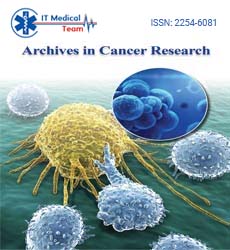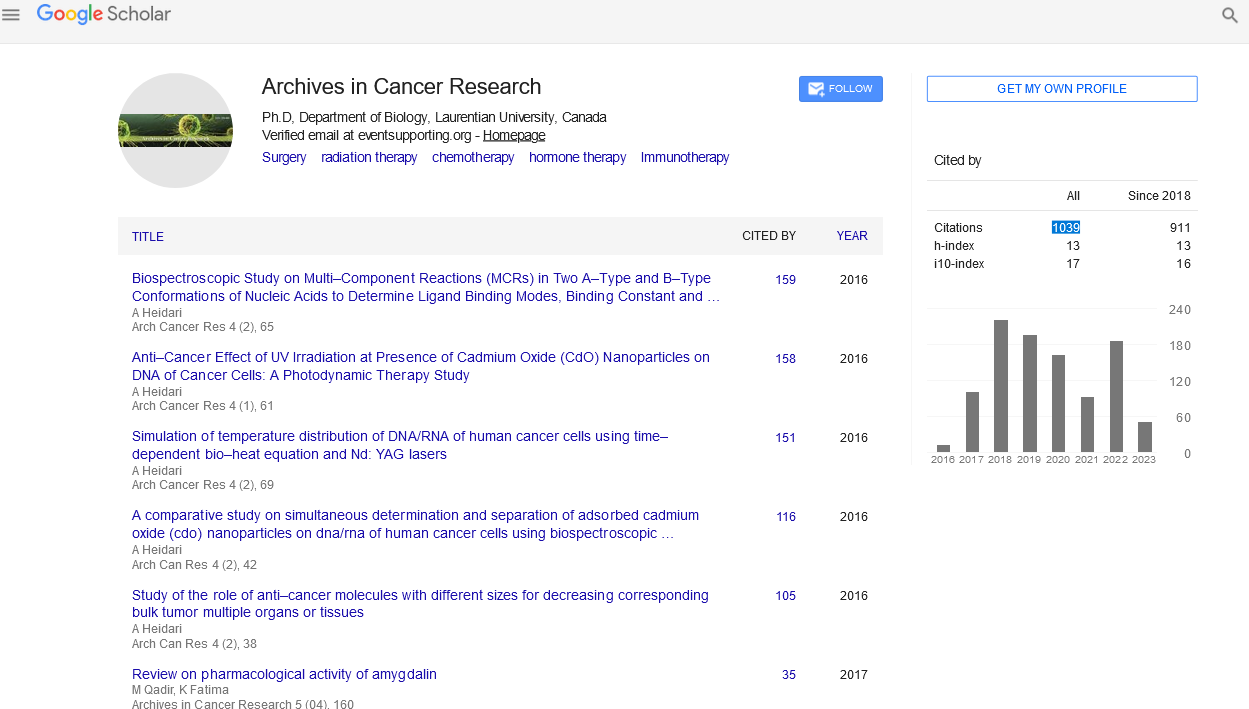Perspective - (2024) Volume 12, Issue 4
Digital Archives: Transforming Cancer Research
Yuin Quian*
Department of Medicine, tanford University, USA
*Correspondence:
Yuin Quian, Department of Medicine, tanford University,
USA,
Email:
Received: 15-Jul-2024, Manuscript No. IPACR-24-15005;
Editor assigned: 17-Jul-2024, Pre QC No. IPACR-24-15005 (PQ);
Reviewed: 31-Jul-2024, QC No. IPACR-24-15005;
Revised: 07-Aug-2024, Manuscript No. IPACR-24-15005 (R);
Published:
15-Aug-2024
Introduction
Digital archives have revolutionized the way cancer research
data is stored, accessed, and utilized. By transitioning from
traditional paper-based methods to sophisticated digital systems,
researchers have gained unprecedented access to vast amounts
of data. This transformation has enhanced collaboration,
facilitated large-scale studies, and accelerated the pace of
discoveries. This article explores the journey from physical to
digital archives, the major digital archiving projects, the
advantages and challenges of digital archives, and their impact on
cancer research.
Description
Transition from physical to digital archives
The transition from physical to digital archives began in the
late 20th century, driven by advancements in computer
technology and the growing need for more efficient data
management. Traditional paper-based archives, while valuable,
had several limitations, including vulnerability to damage,
difficulties in sharing information, and the sheer volume of space
required for storage.
With the advent of digital technology, institutions began to
digitize their records, converting paper documents, images,
and other materials into digital formats. This process involved
scanning physical documents, creating digital databases, and
developing software systems for data management. The
benefits of this transition quickly became apparent, as digital
archives offered greater accessibility, improved searchability,
and enhanced data preservation.
Major digital archiving projects
The Cancer Genome Atlas (TCGA): Launched in 2006, TCGA is
one of the most ambitious cancer research projects to date. It
aimed to catalog genetic mutations responsible for various
cancers by analyzing over 20,000 primary cancer and matched
normal samples spanning 33 cancer types. The data generated
by TCGA is stored in digital archives accessible to researchers
worldwide, facilitating genomic studies and the development of
targeted therapies.
International Cancer Genome Consortium (ICGC): Established
in 2008, the ICGC coordinates cancer genome studies from
multiple countries, aiming to understand the genomic changes
in 50 different cancer types. The consortium’s digital archives
hold comprehensive genomic data that researchers can access
for comparative studies, enhancing global collaboration and
accelerating the pace of cancer research.
Cancer Imaging Archive (TCIA): TCIA is a public repository of
cancer imaging data. It provides access to a wide range of
medical imaging datasets, including CT scans, MRIs, and PET
scans, along with corresponding clinical data. These digital
archives enable researchers to develop and validate imaging
biomarkers, improving cancer diagnosis and treatment planning.
Genomic Data Commons (GDC): The GDC is a comprehensive
data repository that harmonizes genomic and clinical data from
cancer research programs. It supports the National Cancer
Institute’s mission to facilitate data sharing and reproducibility.
By integrating data from various sources, the GDC provides a
unified platform for researchers to explore complex cancer
datasets.
Advantages of digital archives
Accessibility and collaboration: Digital archives provide easy
access to vast amounts of data from anywhere in the world.
Researchers can retrieve and share information seamlessly,
fostering collaboration across institutions and countries. This
global accessibility accelerates the pace of discovery by enabling
researchers to build on each other's work.
Enhanced data preservation: Digital archives offer improved
preservation of data, reducing the risk of loss or damage
associated with physical records. They ensure that valuable
information is maintained over time, with the ability to create
multiple backups and implement robust data security measures.
Improved searchability and analysis: Digital formats allow for
advanced search capabilities, making it easier to locate specific
information within large datasets. Researchers can quickly filter
and analyze data, identifying patterns and trends that might be
overlooked in physical records. This enhanced searchability
accelerates the research process and improves efficiency.
Integration with advanced technologies: Digital archives can
integrate with advanced technologies such as Artificial
Intelligence (AI) and Machine Learning (ML). These tools can analyze large datasets, uncovering insights and correlations that
might not be apparent through traditional analysis methods. AI
and ML have the potential to revolutionize cancer research by
identifying new biomarkers and predicting treatment outcomes.
Case studies
The Cancer Genome Atlas (TCGA): TCGA's comprehensive
digital archive of genomic data has enabled numerous
breakthroughs in understanding cancer biology. For example,
the identification of specific genetic mutations in glioblastoma, a
type of brain cancer, has led to the development of targeted
therapies. TCGA's data continues to support research into
various cancer types, highlighting the power of digital archives in
advancing cancer research.
Cancer Imaging Archive (TCIA): TCIA's repository of imaging
data has facilitated the development of imaging biomarkers for
early cancer detection. Researchers have used TCIA data to
create machine learning models that can accurately identify lung
cancer in CT scans. These models have the potential to improve
early diagnosis and treatment outcomes, demonstrating the
impact of digital archives on clinical practice.
International Cancer Genome Consortium (ICGC): The ICGC's
collaborative approach has resulted in significant advancements
in understanding cancer genomics. By pooling data from
multiple countries, the consortium has identified common and
rare genetic mutations across different populations. This global
perspective is crucial for developing treatments that are
effective across diverse patient groups.
Future directions
The future of digital archives in cancer research holds
immense potential. Several promising directions include:
Integration with Electronic Health Records (EHRs): Linking
cancer research archives with EHRs can provide a more comprehensive view of patient data, combining clinical
information with research findings. This integration can enhance
personalized medicine by tailoring treatments to individual
patient profiles.
Real-time data access: Advancements in cloud computing and
high-speed internet will enable real-time access to digital archives.
Researchers can analyze data as it is generated, accelerating the
research process and enabling more timely discoveries.
Enhanced collaboration platforms: Developing advanced
collaboration platforms that support seamless data sharing and
communication among researchers. These platforms can
facilitate interdisciplinary research, bringing together experts
from different fields to tackle complex cancer challenges.
Patient involvement: Engaging patients in the research process
by providing them with access to their own data and opportunities
to participate in studies. Patient-reported outcomes and realworld
data can enrich digital archives, providing valuable insights
into treatment effectiveness and quality of life.
Conclusion
Digital archives have transformed cancer research by providing
unprecedented access to vast amounts of data, enhancing
collaboration, and enabling advanced analysis techniques. While
challenges remain, ongoing efforts to address data privacy,
standardization, and resource requirements are crucial for
maximizing the potential of digital archives. As technology
continues to evolve, the future of digital archives in cancer
research looks promising, with the potential to drive new
discoveries and improve patient outcomes. By embracing these
advancements, the research community can continue to build on
the legacy of past discoveries and make significant strides in the
fight against cancer.
Citation: Quian Y (2024) Digital Archives: Transforming Cancer Research. Archives Can Res Vol:12 No:4





